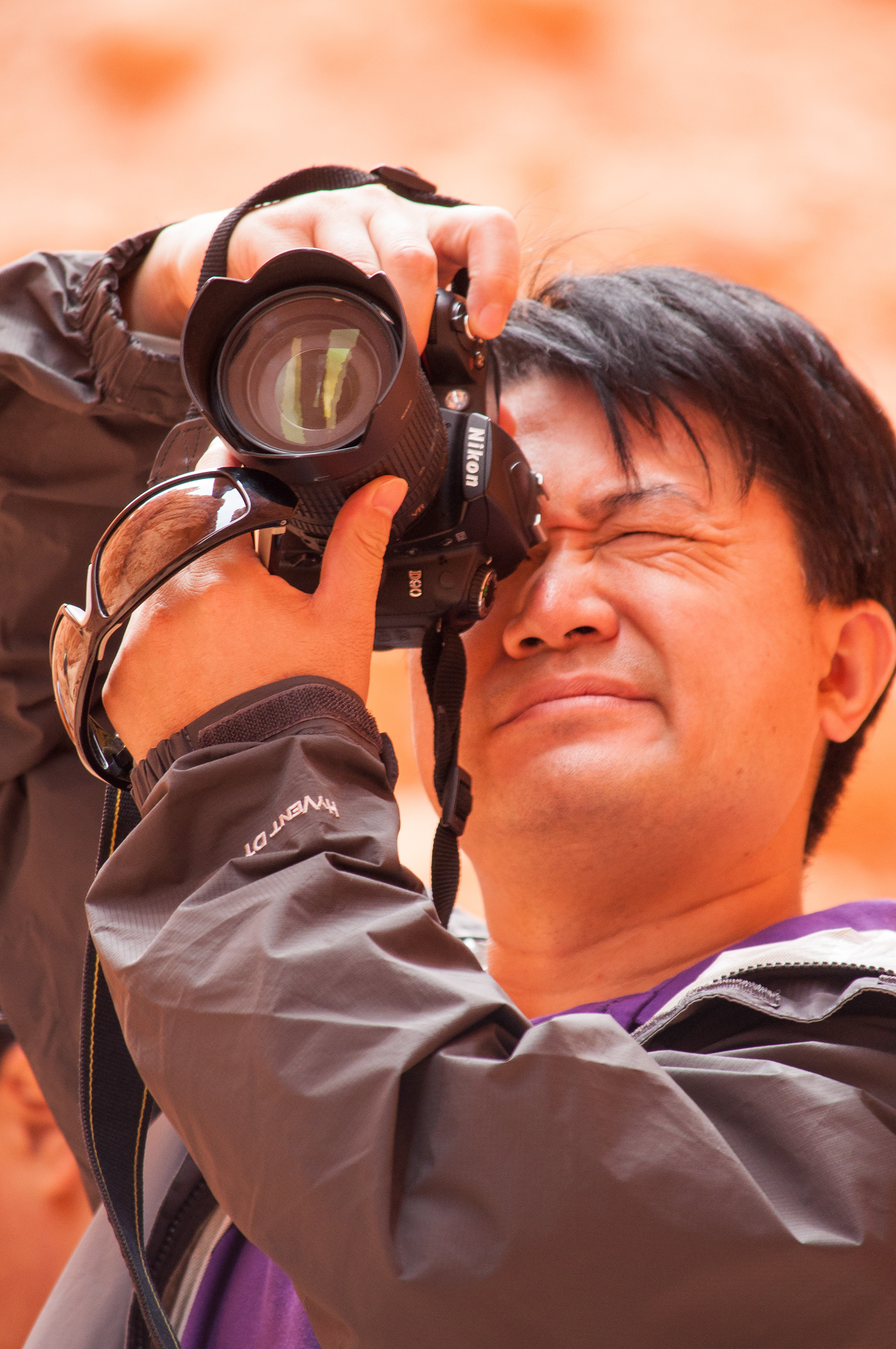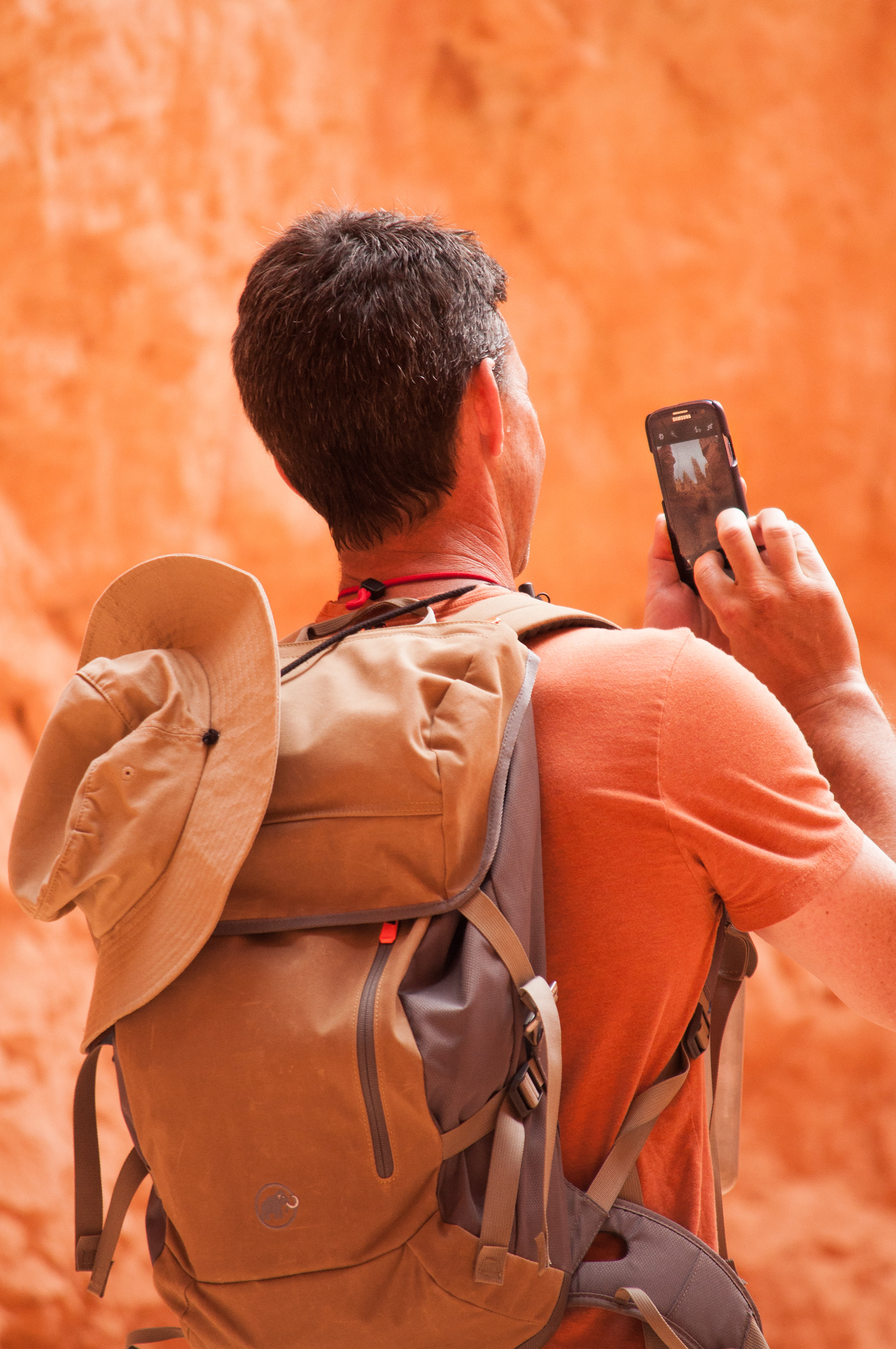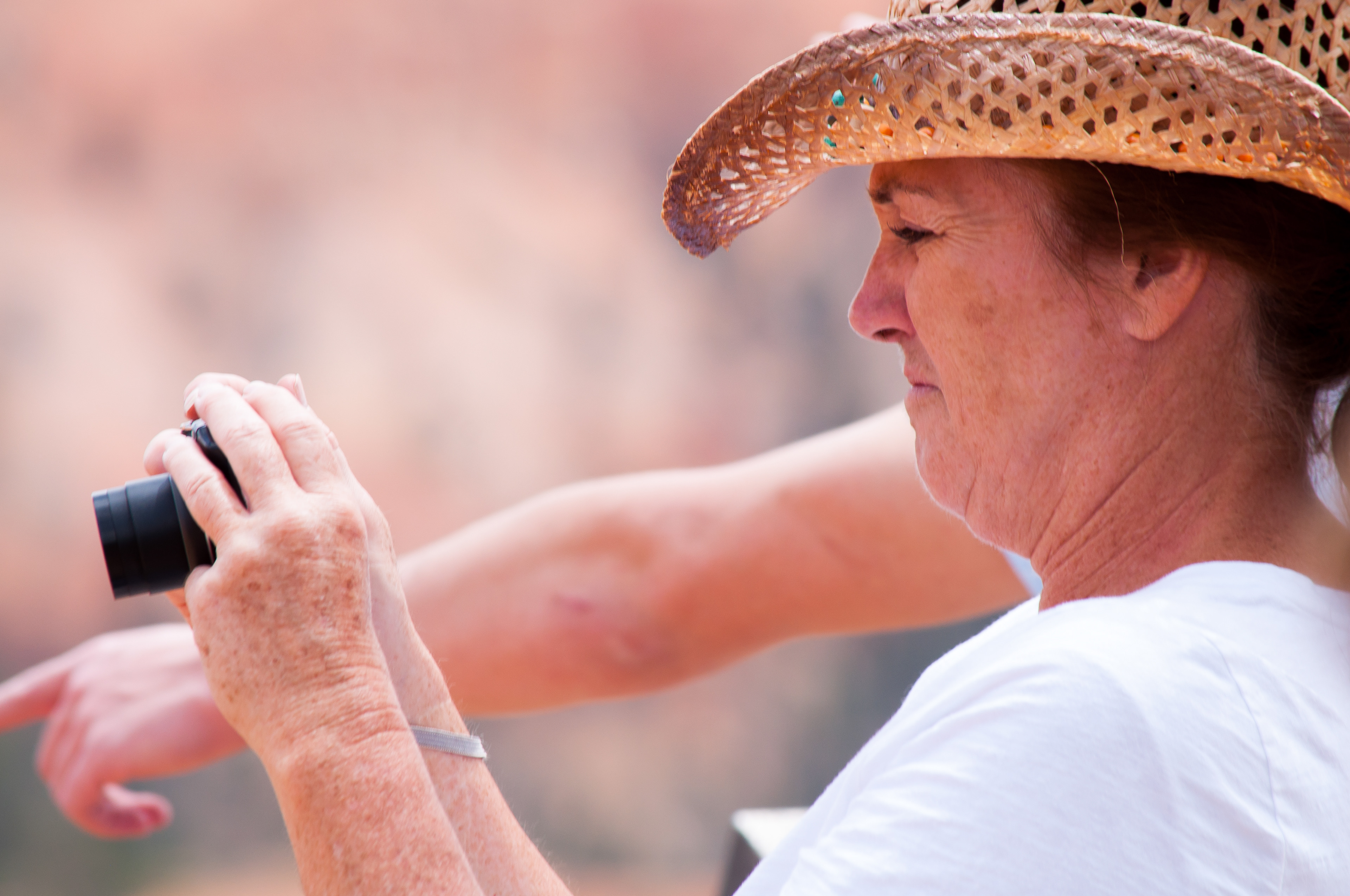Below is an excerpt from my study of how tourists experience national parks through photography. I initially became interested in this subject because I—a tourist who never forgets to bring the camera along—started to question my photographic motives when I noticed that many of my photographs were not unique, but rather reproductions of photographs I had been exposed to previously. I packed my bags and set out on an exploratory journey to discover how the national park tourist’s experience is mediated by photography.
To accomplish this task, I traveled to several different national parks to observe the national park landscape, the tourist, and myself. I traveled to stand at overlooks, gaze upon the natural landscape, and then turn the gaze back upon the tourist. Through my writing, photographing, and reflecting upon my own experiences I contemplated travel, nature, and the tourist experience. This is a thought experiment. Just as each of our own experience is an experiment, my thoughts are an experimentation of understanding and criticizing the world of tourism.
This particular chapter attempts to answer the question that I first encountered when I noticed that many of my photographs from national parks were not unique, and yet were the very reason that I would initially travel to these remote places.
If you wish to read more, you can find my study in its entirety here: medium.com/the-landscape-of-experience
David Ogilvy, often referred to as the “Father of Advertising” in the 1930s and 40s, opined that tourists, “in choosing a vacation sight, set out to physically inhabit the places that had been backdrops for earlier daydreams and fantasies. Luring Tourists was a matter of cultivating imaginative desires to the point where consumers felt compelled to act on them” (1). Advertising agencies knew that photographs were the key to instilling these fantasies into the potential tourist because photographs are able to communicate the essence of a place while simultaneously tantalizing the tourist with a fantasy getaway. When a potential tourist views a photograph of a national park, they do not just see the place, they experience themselves as being there, or wishing that they were. Landscape photographs are not neutral; instead, they are a representation that is controlled by the creator and editors of the image. The photographer, editor, and the person who designs the advertisements or social media posts have an influence on the image and communicate their intentions through photographs. By manipulating a photograph’s meaning, photographers are able to enter and control a potential tourist’s consciousness and subjective experience (2).
Seeing images of national parks on social media replicates the experience of being there and by creating a virtual experience may entice a potential tourist to actualize the experience by physically visiting the park.
Overlooks are constructed areas of parks that demark an area with concrete, railings, and signage that inform a tourist that here they can find the best view and the best summary of what the park has to offer. Where these overlooks are built is intentional, and the location often has its roots in photography. In 1934, famous photographer Ansel Adams photographed Yosemite Valley looking east over El Capitan, Bridalveil Falls, and Half Dome, capturing what is possibly the most iconic photograph of Yosemite. Today, exactly where Adams stood to take this photograph, there stands an overlook called Tunnel View, one of the most popular overlooks in the park. During the summer it is estimated that five to seven thousand people visit the overlook per day (3). Adams’ photograph generated this particular view’s popularity, and now tourists flock to the overlook not only to see the spectacular vista, but also to photograph it, effectively replicating Adams’ photograph.
Since Ansel Adams made his famous photograph of Yosemite valley the photograph has been endlessly replicated.
Overlooks are consistently built where famous photographs were once taken because of the photographer’s aesthetic authority and the popularity that their photographs can create. In Yellowstone, at what is now known as “Lookout Point,” several photographers and painters had reproduced the view from this vantage point. As a result of encountering these aesthetic reproductions, tourists sought out the very same spot. The resulting foot traffic became so dense that the park superintendent decided to build a formal overlook in this location (4). Because of the ease and popularity of overlooks the tourist’s eye is concentrated at only a few vantage points, resulting in the reproduction of the same photograph over and over again.



70% of Bryce Canyon tourists never leave the roads and overlooks that make up only a small portion of the park. At these overlooks tourists will photograph Bryce Canyon in an attempt to capture its essence in its totality.
One study of Bryce Canyon visitors reported that 71% of tourists surveyed participated in photography and 70% of tourists only view the park from the scenic drive and overlooks. The infrastructural design of parks encourages this kind of experience by constructing roads and parking lots that lead directly to overlooks or attractions. The vast majority of tourists coming to Bryce Canyon only get out of their cars in order to see and photograph the landscape presented to them by overlooks. They participate in this kind of experience because it is the quickest and easiest way to experience a national park, but it is also an experience that is solely mediated by photography. By only viewing a park from the vantage points of overlooks, tourists are experiencing the park mediated by and as if it were a photograph.
There is always some kind of interaction between the tourist and the attraction, but sometimes symbolism can stand in between the two (6). For example, a landscape photograph becomes a symbol of nature. The tourist standing at an overlook and viewing the landscape as they would a photograph is distanced from nature. Instead of directly interacting with the natural elements of the national park, they are looking at a landscape as if it were a photograph, something that is incapable of interaction and only an object of observation. Tourists travel hundreds of miles, spend their savings, and dedicate their leisure time to come to national parks in order to experience and become closer to nature, just like the billboards promised. However, when they get there they never truly interact with nature. The tourist will settle for a symbol of nature, an image that is a summary of the whole.
Philosopher and cultural critic, Walter Benjamin claims that not only tourists but also the general masses are in search of what he calls an aura. According to Benjamin, an aura sought by a tourist is “the desire… to ‘get closer’ to things, and their equally passionate concern for overcoming each thing’s uniqueness by assimilating it as a reproduction” (7). The national park tourist desires to “get closer” to nature. Once tourists arrive at an overlook that provides them with an image of the totality of the park’s nature, they grasp it by photographing the landscape. The tourist may have desired to “get closer,” but in reality they have only viewed and photographed an image of nature. According to the Bryce Canyon survey, 70% of tourists are content with only photographing the landscape. In other words, they have found their aura by capturing the essence of the park through photography.


It is the photograph that is the standard by which the tourist sets their expectations. Photographs have become the mark (representation, standard, embodiment) of beauty, rather than the world. It is the photographs that tell the tourist where to visit to see the world's beauty and what it should look like when they get there. The photographing tourist becomes obsessed with re-creating the beauty of another rather than appreciating and exploring the beauty of their own experiences.
A national park tourist may find more meaning in sections of the park that have their own special features. When these special features are encountered, they are combined with other experiences and can create a synthesis that is unique and beyond the typical experience of overlooks. Famous 20th century photographer Henri Cartier-Bresson believes that by photographing parts of an environment, the photographer can find the essence of the totality of the scene. One could spend a lifetime inside a national park and never experience the vast landscape completely, but by seeing, and possibly photographing, many fragments one may piece together a synthesis of the whole. National park tourists travel to parks with the intention of experiencing the park as a whole. They long for a totality. However, the tourist’s desire for the totality can overpower their will to seek out these fragments. In order to reach Thor's Hammer, The Wall of Windows, or any number of named (and therefore deemed significant) natural attractions, the tourist must leave the comfort of parking lots and overlooks to get out and hike. To find, encounter, and synthesize fragments into a collective experience takes effort and intentionality on the part of the tourist.
By contrast, the built infrastructure of national parks provides a much simpler way to experience the seeming totality of the park through the landscape. A landscape is holistic, and the whole park is encompassed in its imagery. Furthermore, it is easily accessible. Overlooks have been designed to lay out the essence of the park in a predetermined image for the tourist to experience and then photograph in order to experience it over and over again. This kind of national park experience has become the norm, a quick and standard experience that can be homogenous and impersonal. Tourists desire to seek out the geographic essence, or totality, of a place. However, once they are predisposed to the iconic landscape imagery that already claims a totality of the experience, tourists believe they will find it again through their own “snapshot” reproductions.
1) Popp, The Holiday Makers, (116).
2) MacCannell, The Ethics of Sightseeing, (119).
3) United States. National Park Service. "Tunnel View Overlook Rehabilitation." National Parks Service. U.S. Department of the Interior. Accessed 17 March 2015.
4) Greenwald, Emily. 2007. On the History of Photography and Site/Sight Seeing at Yellowstone. Environmental History 12, no. 3: 654-660. America: History & Life, EBSCOhost. Accessed February 21.
5) United States. National Park Service. Rocky Mountain Regional Office. General Management Plan, Bryce Canyon National Park, Utah. Denver: National Park Service, US Dept of the Interior, 1987.
6) MacCannell, The Ethics of Sightseeing, (119).
7) Benjamin, Walter, and Michael William Jennings. The Work of Art in the Age of Its Technological Reproducibility, and Other Writings on Media. Cambridge, Massachusetts: Belknap Press of Harvard University Press, 2008, (23).
